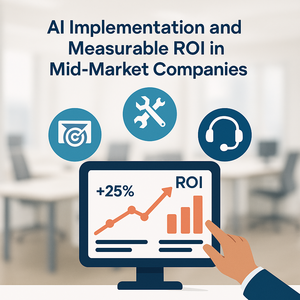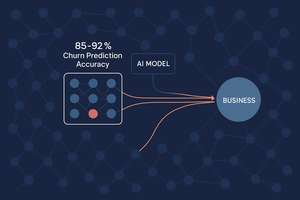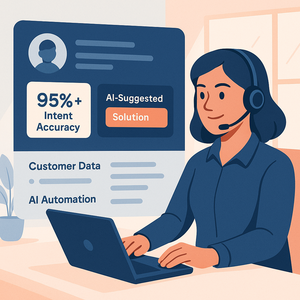Navigating the AI Transformation Tightrope: Balancing Innovation, Regulation, and Human Capital
The artificial intelligence landscape in late 2025 presents a complex picture of immense opportunity tempered by significant operational challenges....
7 min read
 Peter Vogel
:
Jun 2, 2025 4:33:05 AM
Peter Vogel
:
Jun 2, 2025 4:33:05 AM

Last week saw AI evolve at a dizzying pace, presenting both transformative opportunities and complex ethical dilemmas. From new AI models and hardware innovations to regulatory shifts and workforce anxieties, the AI landscape is in constant flux. New regulations in the EU seek to impose transparency on AI-generated content, while the UK government is investing billions to upskill its workforce in critical AI-related areas. These developments underscore the increasing importance of responsible AI adoption and strategic implementation for businesses aiming to thrive.
This article distils the most critical AI news and developments into actionable insights, helping organisations navigate this dynamic environment and leverage AI responsibly. We'll explore the double-edged sword of AI-driven content creation, the strategic imperative of AI skills in the workforce, the transformative potential of AI hardware integration, the ethical tightrope of algorithmic bias, and the next frontier of operational efficiency. These insights are tailored for key decision-makers such as Operations/Technology Executives, Marketing Leaders, Growth-Focused CEOs, Sales Directors, Customer Service Leaders, and HR/Training Leaders, providing the knowledge needed to drive strategic AI initiatives within their organisations and ensure competitive advantage.

AI is now an integral part of content strategies, automating repetitive tasks and driving personalisation at scale. Marketing teams are leveraging these tools to enhance efficiency and reach wider audiences, yet this comes with increased scrutiny regarding transparency and authenticity. This week, the EU enforced the AI Transparency Act for marketing content, requiring clear labelling of AI-generated material to foster consumer trust. This regulation marks a significant step towards ensuring accountability in digital marketing (EU Parliament, 2025).
On the technological front, OpenAI launched Sora 3.0, offering real-time video editing capabilities that enable faster, hyper-localised ad creation (TechCrunch, 2025). This advancement promises to significantly reduce production timelines and allow for more targeted marketing campaigns. However, it also raises concerns about the potential for misuse, including the creation of deepfakes. Meanwhile, on platforms like TikTok, AI influencers are gaining traction, sometimes outperforming their human counterparts in engagement (Social Media Today, 2025). While this trend reduces reliance on talent costs, it sparks broader debates about authenticity and the long-term impact on influencer marketing. To succeed in this evolving landscape, businesses must balance efficiency gains with ethical considerations. A recent study indicates that 42% of consumers distrust brands that don’t disclose AI-generated content (Edelman Trust Barometer, 2025). Companies are responding by adopting ethical AI guidelines, with 60% now implementing such frameworks for their marketing activities (Deloitte, 2025). Navigating this complex landscape requires a strategic approach that prioritises transparency and responsible AI deployment to build trust and maintain brand reputation.

AI is not only transforming business operations but also reshaping the workforce. New roles are emerging, and existing positions are evolving to require a blend of technical and soft skills. A recent PwC report forecasts the creation of 12 million new jobs in Europe by 2030, driven by AI in sectors such as AI training, healthcare diagnostics, and green energy optimisation (PwC, 2025). This underscores the need for strategic workforce planning and investment in upskilling initiatives.
In response to this shift, governments and corporations are taking action. The UK government has launched the National AI Skills Programme, allocating £2.3 billion to upskill 1.5 million workers in AI literacy, cybersecurity, and data analytics by 2027 (gov.uk, 2025). This initiative aims to address a projected skills gap and position the UK as a leader in ethical AI implementation. Furthermore, Microsoft has partnered with global unions to retrain 500,000 workers in AI tools and robotics maintenance, focusing on manufacturing and logistics (news.microsoft.com, 2025). These collaborations set a precedent for proactive workforce transitions in the age of AI.
Despite the potential for job creation, employee anxieties persist. An OECD survey reveals that 72% of employees believe AI tools improve productivity, but 58% fear job redundancy (OECD, 2025). Addressing these concerns requires transparent communication, fair transition strategies, and a focus on developing hybrid skills that combine technical expertise with uniquely human capabilities. LinkedIn's Workforce Report indicates that 65% of companies now prioritise hiring for hybrid skills over pure technical expertise (LinkedIn, 2025). Investing in these skills is crucial for building a resilient and adaptable workforce for the future.

The synergy between AI algorithms and specialised hardware is driving a technological revolution across industries, enhancing efficiency and opening new possibilities. Integrated systems have evolved to include application-specific integrated circuits (ASICs), field-programmable gate arrays (FPGAs), and neuromorphic chips that mimic biological neural networks. These innovations have reduced energy consumption by 40% compared to 2020 benchmarks while accelerating inference speeds significantly.
The rise of edge computing and decentralised AI, fuelled by the proliferation of edge devices like autonomous vehicles and industrial IoT sensors, has increased the demand for localised AI processing hardware. Qualcomm's Snapdragon X Elite platform integrates on-device AI accelerators, enabling real-time language translation and image recognition without cloud dependency. This localised processing mitigates latency issues and enhances data privacy by minimising transmission needs. By 2025, over 65% of enterprises have adopted edge-AI solutions, reducing cloud costs by an average of 28%.
As organisations continue to integrate AI into their processes, strategic investments in advanced hardware are essential. Neuromorphic chips, such as Intel’s Loihi 3, are poised to revolutionise AI by enabling continuous learning with minimal energy consumption. Success hinges on cross-industry collaboration to standardise development frameworks and address implementation challenges, including ensuring robust data security measures are in place at the hardware level.

Ethical concerns surrounding AI are growing, encompassing bias, misinformation, and potential existential threats. The EU's AI Liability Directive is a landmark step, holding AI developers accountable for harms caused by their systems and requiring disclosure of training data sources (European Commission, 2025). This regulation sets a global precedent and underscores the need for proactive risk management.
Efforts to mitigate AGI risks are also gaining traction. OpenAI's Project Guardian aims to address these concerns through technical safeguards, including "kill switches" and real-time ethics audits (MIT Technology Review, 2025). However, this initiative has sparked debate about the sufficiency of self-regulation by tech firms. The urgency of these concerns is highlighted by the increasing prevalence of deepfake scandals, particularly in political contexts. The UK Electoral Commission reports that AI-generated videos of political candidates led to a 12% drop in voter trust during the recent general election (BBC News, 2025).
To navigate this ethical tightrope, organisations must implement robust AI governance frameworks, prioritise transparency, and address potential biases to ensure responsible AI adoption. Rigorous bias audits for AI systems are essential, particularly in sensitive applications such as facial recognition and hiring processes. This requires a proactive approach that balances innovation with ethical considerations and navigates complex regulatory landscapes, ensuring compliance with potential fines of up to 6% of global revenue for non-compliance in bias audits.

AI is transforming operations, driving cost savings, and optimising workflows. Companies are increasingly leveraging AI-driven supply chain tools to mitigate disruptions and reduce delays, leading to significant improvements in efficiency (Forbes, 2025). Generative AI is also revolutionising customer service, cutting costs and freeing staff for complex tasks (TechCrunch, 2025). Vodafone and NatWest have deployed generative AI chatbots, resolving 80% of customer queries without human intervention and freeing staff for complex tasks (TechCrunch, 2025).
Even public sector organisations are embracing AI to enhance operational efficiency. The NHS has adopted AI for administrative automation, reducing patient wait times by 35% through streamlined appointment scheduling and medical record management (BBC, 2025). These examples demonstrate the broad applicability of AI in enhancing efficiency and alleviating workforce shortages. Organisations that strategically identify opportunities for AI to automate repetitive tasks, optimise processes, and enhance efficiency will be best positioned for success. AI-driven predictive maintenance, for example, cuts manufacturing downtime by 55% (Gartner, 2025), while AI-powered document processing saves UK firms an estimated £12.5 billion annually (PwC, 2025).
However, managing workforce transitions and ensuring employees are equipped with the skills needed to work alongside AI remains a key challenge. This requires proactive planning, investment in training and reskilling programmes, and a commitment to creating a supportive environment for employees adapting to new roles and responsibilities. By focusing on the human aspects of AI implementation, organisations can unlock its full potential while minimising disruption and maximising employee engagement, potentially leading to higher job satisfaction as repetitive tasks are automated (Deloitte, 2025).

The artificial intelligence landscape in late 2025 presents a complex picture of immense opportunity tempered by significant operational challenges....

The discourse surrounding artificial intelligence is maturing. Across boardrooms and operational teams, the conversation has decisively shifted from...

The artificial intelligence landscape is no longer a distant frontier; it's rapidly reshaping the present, demanding a strategic response from...